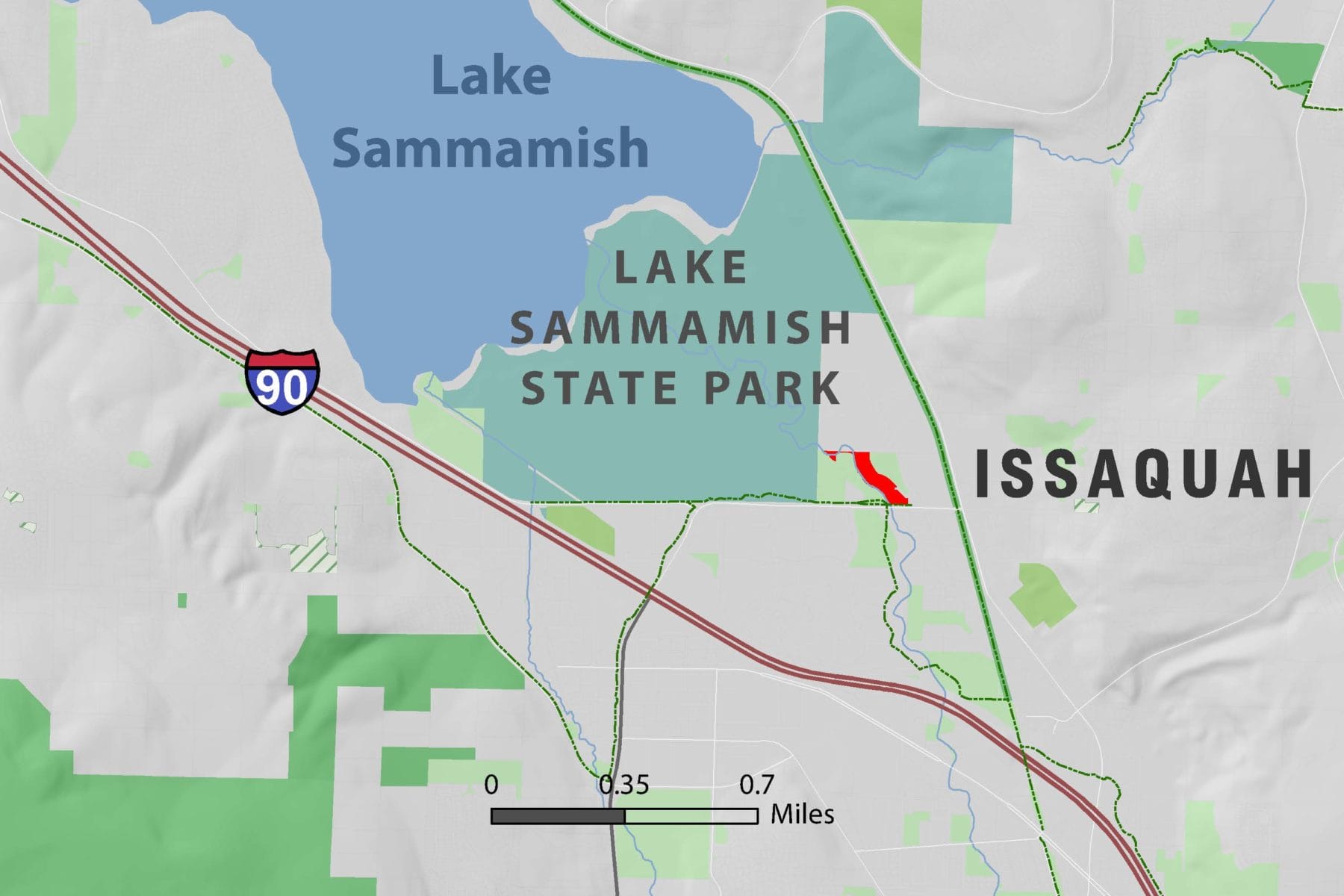Lake Sammamish State Park Adds 5 Acres
The map of Lake Sammamish State Park is getting a fresh update as a generous donation of land from Issaquah-based Lakeside Industries has increased the park’s size by five acres. What lies within these five-acres is especially exciting as the newly acquired property just east of the park includes nearly 1,200 linear feet along the eastern bank of Issaquah Creek. Immediate benefits of the now publicly owned land include expanding upon 20-years of successful habitat restoration efforts and improved recreational trail connectivity, creating a 2.5-mile loop at the south end of the park.
Acquiring public land of any size in an urban area and that also happens to be specifically adjacent to a carefully managed puzzle of restoration work is challenging at best. The windows of opportunity are typically narrow and require an abundance of diligence; otherwise, promising acquisitions stall or fade away and, once sold to another private owner, the odds of getting another shot at it are slim. Persistence matters when it comes to bringing public agencies and private partners together to the table at just the right time.
The Mountains to Sound Greenway Trust enjoyed taking on the proactive role earlier this year, in the process of working with the Washington State Parks and Recreation Commission to write a grant to the Lake Washington/Cedar/Sammamish Watershed/King County Flood Control District to acquire the property, which Lakeside was willing to sell below market value. The initial idea was to seek additional funding for long-term restoration work after the successful transfer of land. However, once the Greenway Trust invited representatives from Lakeside Industries to walk the site together and see the bigger picture of restoration habitat and recreation connectivity potential first-hand, the local business decided to donate the 5.32 acre property outright to Washington State Parks.
“We recognized the greater value that the parcel offered to stream conservation efforts, salmon restoration and the preservation of state lands,” said Timothy Lee, CEO of Lakeside.
The timeline for restoration work planned for the site has moved up now that the grant funds can be used sooner than expected with on-the-ground work beginning next spring. The removal of invasive weeds will be carried out by volunteers, AmeriCorps members, and other partners to make room for native shrubs and trees, including native conifers, to be planted in along the stream banks in the coming years. A birds-eye-view of the park map shows just how important this acquisition is to the larger story of transforming the ecological health of Issaquah Creek piece by piece.
Improving habitat conditions in the Issaquah Creek itself is a critical piece in the overall restoration plan that will be informed by a study, funded by The Boeing Company, focusing on the lack of sufficient large woody debris (LWD) – normally present in a  healthy creek – in the lower stretch of the creek. LWD helps protect young Chinook salmon by creating natural pools and other in-water features that encourage spawning, rearing, resting, food production, and refuge habitat for threatened salmon. The proximity of the land donation is significant as it means that nearly all the creek from E. Lake Sammamish Parkway to the lake is publicly owned or conserved.
healthy creek – in the lower stretch of the creek. LWD helps protect young Chinook salmon by creating natural pools and other in-water features that encourage spawning, rearing, resting, food production, and refuge habitat for threatened salmon. The proximity of the land donation is significant as it means that nearly all the creek from E. Lake Sammamish Parkway to the lake is publicly owned or conserved.
“Washington State Parks is grateful to the Greenway Trust for facilitating the donation by Lakeside Industries,” said Nikki Fields, Washington State Parks planner. “We look forward to working with the community to improve the creek for salmon habitat and to improve access for visitors.”
 Managing a large restoration project takes time – often years – but the difference in the acceleration is made when collaborators are ready to act. It is the forward thinking investment of residents, volunteers, public and private partners that will help reshape the future story of Lake Sammamish State Park – a place for connected recreation and thriving natural habitats. The addition of the property at Lake Sammamish State Park provides a pivotal connection between the park and the city, allows greater use of trails, and furthers the stewardship mission of State Parks by restoring the creek.
Managing a large restoration project takes time – often years – but the difference in the acceleration is made when collaborators are ready to act. It is the forward thinking investment of residents, volunteers, public and private partners that will help reshape the future story of Lake Sammamish State Park – a place for connected recreation and thriving natural habitats. The addition of the property at Lake Sammamish State Park provides a pivotal connection between the park and the city, allows greater use of trails, and furthers the stewardship mission of State Parks by restoring the creek.
“Lakeside’s donation is a great example of the power of collaboration and storytelling,” said Mackenzie Dolstad, Greenway Trust stewardship program manager. “By working with State Parks and Lakeside Industries, we were able to make progress on salmon conservation and recreational enhancement goals and tie into the larger story of the long-term efforts to improve and enhance Issaquah Creek.”
Keep an eye on our volunteer events for restoration opportunities along Issaquah Creek!





